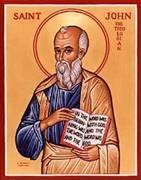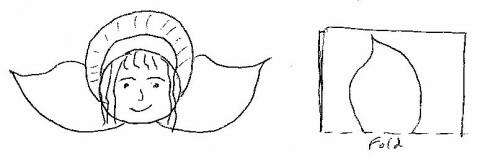St. John and the Revelation
JOHN/REVELATION

Objectives:
- Students should be able to identify the apostle John as the disciple John, son of Zebedee and brother of James.
- Students should be able to identify the Book of the Revelation as John’s writing.
- Students should be able to identify the Second Coming.
Suggested Lesson Plan:
- Open with prayer.
- Have each of the students read one of these passages and summarize for the group; they are in chronological order: Luke 5:7-11, Mark 5:35-42, Mark 6:7-13, Luke 9:28-32, John 13:21-26, John 19:25-27, John 20:1-8, Acts 3:1-6, I John 1:1-3, Revelation 1:9-11. Supplement with the following story; have ready the icons of the Transfiguration, Crucifixion, Ascension, and Pentecost to identify John in each (and break up the story):
After the Resurrection, John was one of the leaders of the early Church. He helped Peter and James in guiding the church in Jerusalem. Then, John traveled to Asia Minor and settled in the city of Ephesus. He wrote down his memories from his life with Jesus in the Gospel of John. From Ephesus he led the church in Asia. John was known for the loving concern he had for his brothers and sisters. A story is told that, while traveling in a certain city, John saw a young man and entrusted him to the bishop of the city to teach him about the Lord. But, when John came back to the city, he was told that the young man had made bad friends and had become a robber. This made John very sad, and he went into the mountains where the robbers lived. He was captured by the robbers and found the young man and told him that Jesus still loved him. The young man then cried and said that he was sorry for his evil way of life and went back to the church. So, the apostle John cared for his churches with love and charity.
When John was already an old man, loved by Christians everywhere, he was the only one of the twelve still alive. When the Emperor Domitian, a cruel and wicked ruler, came to the throne, he ordered John captured by the soldiers and brought to the Emperor in Rome. There, he tried to kill John in a pot of boiling oil, but John was not hurt at all. (Remember the story of the three men in the fiery furnace?) Since he could not kill the apostle, the emperor sent him to the deserted island of Patmos. There John had the great vision of the Lord and wrote the book we now call “The Revelation” in the Bible.
Finally, Domitian died and John was able to go back to Ephesus. From there he wrote three letters, which we now have in our Bible as the “Epistles of St. John”. As an old man, John told the people over and over to love each other. John died peacefully in Ephesus and joined the Lord he had loved so well.
- The Book of the Revelation is much to complex and the subject of too much theological controversy to approach with this age group. But – everyone has dreams. Let them discuss their dreams. What is the difference between a dream and a vision? There are many instances of dreams and visions in the Old Testament that we already have studied – the dreams of Pharaoh, the dreams of the butler and the baker, the vision of Samuel, the visions of the prophets (e.g. Ezekiel and the bones). And in the gospels, Joseph had two life-changing dreams – when God told him to marry the Theotokos and when the angel told him to escape from Bethlehem to Egypt. Review these stories. God can speak to us in both visions and dreams. John’s vision was full of angels and trumpets – the major theme is the Second Coming, when Jesus will come again in glory (as He promised) and judge the world.
- Do a learning activity: In Revelation, God sends a message through John to the 7 churches of Asia. Look up the names of these churches in Revelation 1:11. Find each of these churches on a map. Draw a small church shape, write the name of the church, and from Revelation 2 and 3 find one important thing God had to say to each church and write it also on the building. Use thumb tacks to attach the paper churches in the correct locations on your classroom map or bulletin board. Do any of the messages God gave to those long-ago churches apply to us today? Why or why not?
- What is an angel? Ask the students to describe as they understand angels. Angels are God’s attendants and messengers. The Orthodox Church teaches that there are 9 “choirs” of angels: angels, archangels, powers, authorities, principalities, dominions, thrones, cherubim and seraphim. Do the students remember any of these mentioned in our liturgy? Angels are invisible (most of the time; can you think of an exception? The Annunciation!), of tremendous power and strength. They don’t have bodies as we know them. Try to fill these blanks with either “people” or “angels” or “angels and people”:
_______________ were created by God. _________are always young.
_______________have bodies. _________think and do things.
_______________never die. _________need to eat and drink.
_______________have names.
- Make an paper plate angel head: Take a large paper plate before class, cut out the center and spray paint gold (or use gold glitter in class). Take a small plate and draw face and add hair of yarn or fabric or felt. Cut wings from a 12x18 sheet of construction paper in white. Glue or staple face in front of halo and wings behind.

- Close with prayer: Lord, let me see You this week all around me in my dreams and in your invisible helpers, the angels.